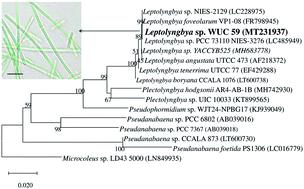当前位置:
X-MOL 学术
›
Nanoscale Adv.
›
论文详情
Our official English website, www.x-mol.net, welcomes your feedback! (Note: you will need to create a separate account there.)
Biogenic synthesis of silver nanoparticles using cyanobacterium Leptolyngbya sp. WUC 59 cell-free extract and their effects on bacterial growth and seed germination
Nanoscale Advances ( IF 4.7 ) Pub Date : 2020-07-30 , DOI: 10.1039/d0na00357c Yadvinder Singh 1 , Sandeep Kaushal 2 , Ramandeep Singh Sodhi 3
Nanoscale Advances ( IF 4.7 ) Pub Date : 2020-07-30 , DOI: 10.1039/d0na00357c Yadvinder Singh 1 , Sandeep Kaushal 2 , Ramandeep Singh Sodhi 3
Affiliation

|
The biogenic synthesis of metal nanoparticles (NPs) is of great significance, as it renders clean, biocompatible, innocuous and worthwhile production. Here, we present a clean and sustainable route for the synthesis of silver nanoparticles (Ag NPs) using the cell-free aqueous extract of the cyanobacterium Leptolyngbya sp. WUC 59, isolated from polluted water and identified using a polyphasic approach. The conformation and characterisation of the as-synthesized biogenic Ag NPs was carried out using various sophisticated techniques like UV-visible (UV-Vis), X-ray diffraction (XRD), Fourier transform infrared (FTIR), energy dispersive X-ray spectroscopy (EDS) and high-resolution transmission electron microscopy (HRTEM). The sharp colour change and emergence of a characteristic peak at 430 nm in the UV-Vis spectrum confirm the formation of the Ag NPs. The morphological and physical appearance indicated that the synthesized Ag NPs are crystalline with a typical size of 20–35 nm. Furthermore, the bio-reduced nanoparticles were explored for their antibacterial activity against Bacillus subtilis and Escherichia coli bacteria, seed germination effects and early seedling growth of wheat (Triticum aestivum L.). The Ag NPs significantly suppressed the growth of both Bacillus subtilis and Escherichia coli bacteria with the treatment of 10 mg L−1 concentration within the initial 3 hours. The lower concentration (25 mg L−1) of the synthesized Ag NPs significantly enhanced the seed germination and early seedling growth of wheat in comparison to the control on the 4th and 8th day. The present investigations show that the use of the cyanobacterium Leptolyngbya sp. WUC 59 provides a simple, cost-effective and eco-friendly tool for the synthesis of Ag NPs. Moreover, it could have great potential for use as an alternative to chemical-based bactericides not only in pharmaceutical industries, but also to control bacterial diseases in agricultural crops.
中文翻译:

使用蓝藻 Leptolyngbya sp. 生物合成银纳米粒子。WUC 59 无细胞提取物及其对细菌生长和种子萌发的影响
金属纳米颗粒 (NPs) 的生物合成具有重要意义,因为它可以提供清洁、生物相容、无害和有价值的生产。在这里,我们提出了一种使用蓝藻Leptolyngbya的无细胞水提取物合成银纳米粒子 (Ag NPs) 的清洁且可持续的途径sp。WUC 59,从受污染的水中分离出来,并使用多相方法进行鉴定。使用各种复杂的技术,如紫外可见 (UV-Vis)、X 射线衍射 (XRD)、傅里叶变换红外 (FTIR)、能量色散 X 射线光谱,对合成的生物 Ag NPs 进行构象和表征(EDS) 和高分辨率透射电子显微镜 (HRTEM)。UV-Vis 光谱中 430 nm 处出现的急剧颜色变化和特征峰的出现证实了 Ag NPs 的形成。形态和物理外观表明,合成的 Ag NPs 是晶体,典型尺寸为 20-35 nm。此外,研究了生物还原纳米颗粒对枯草芽孢杆菌和大肠杆菌的抗菌活性小麦 ( Triticum aestivum L.)细菌、种子萌发效应及早期幼苗生长。Ag NPs在最初的 3 小时内以10 mg L -1浓度处理,显着抑制了枯草芽孢杆菌和大肠杆菌的生长。与对照相比,在第 4 天和第 8 天,合成的 Ag NPs 的较低浓度(25 mg L -1 )显着增强了小麦的种子萌发和早期幼苗生长。目前的研究表明,蓝藻Leptolyngbya的使用sp。WUC 59 为合成 Ag NPs 提供了一种简单、经济高效且环保的工具。此外,它不仅可以作为化学杀菌剂的替代品用于制药行业,还可以用于控制农作物的细菌性疾病。
更新日期:2020-09-16
中文翻译:

使用蓝藻 Leptolyngbya sp. 生物合成银纳米粒子。WUC 59 无细胞提取物及其对细菌生长和种子萌发的影响
金属纳米颗粒 (NPs) 的生物合成具有重要意义,因为它可以提供清洁、生物相容、无害和有价值的生产。在这里,我们提出了一种使用蓝藻Leptolyngbya的无细胞水提取物合成银纳米粒子 (Ag NPs) 的清洁且可持续的途径sp。WUC 59,从受污染的水中分离出来,并使用多相方法进行鉴定。使用各种复杂的技术,如紫外可见 (UV-Vis)、X 射线衍射 (XRD)、傅里叶变换红外 (FTIR)、能量色散 X 射线光谱,对合成的生物 Ag NPs 进行构象和表征(EDS) 和高分辨率透射电子显微镜 (HRTEM)。UV-Vis 光谱中 430 nm 处出现的急剧颜色变化和特征峰的出现证实了 Ag NPs 的形成。形态和物理外观表明,合成的 Ag NPs 是晶体,典型尺寸为 20-35 nm。此外,研究了生物还原纳米颗粒对枯草芽孢杆菌和大肠杆菌的抗菌活性小麦 ( Triticum aestivum L.)细菌、种子萌发效应及早期幼苗生长。Ag NPs在最初的 3 小时内以10 mg L -1浓度处理,显着抑制了枯草芽孢杆菌和大肠杆菌的生长。与对照相比,在第 4 天和第 8 天,合成的 Ag NPs 的较低浓度(25 mg L -1 )显着增强了小麦的种子萌发和早期幼苗生长。目前的研究表明,蓝藻Leptolyngbya的使用sp。WUC 59 为合成 Ag NPs 提供了一种简单、经济高效且环保的工具。此外,它不仅可以作为化学杀菌剂的替代品用于制药行业,还可以用于控制农作物的细菌性疾病。



























 京公网安备 11010802027423号
京公网安备 11010802027423号